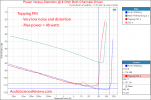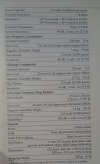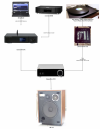The objectivist in me can tell you those mps are way more powerful than the PA5!I have a DIY amp with the Hypex NC502MP module which is a module that combines amplifier and power supply on one board. This DIY uses the common Ghent case. I don't like the Ghent case--it is too small, too tight a fit. I bought the amp from someone else who put it all together. The unit works fine. I'd like to put together a DIY Hypex based or Purifi based 2 channel stereo amp and do it in a bigger more spacious case than the standard Ghent cases. I have such a case that I bought. You can also get basic audio equipment cases from Chinese sources (Aliexpress) or from equipment supply stores for pro equipment. There is at this time no source for Hypex NC series or Purifi amp modules that I know of. Two questions: 1) Will the Hypex NC and Purifi amp modules continue indefinitely to be unavailable except for manufacturers and so I should give up hoping to buy one or the other? Is the Topping PA5 of such sound quality that the 'objectivist' specialists in ASR conclude there is very little if any sound quality identifiable difference between the Hypex NC MP modules, the Purifi modules and the Topping PA5 for general home listening (assuming that I do not need a high power amp)? Assuming a small room with efficient speakers and I don't play music loud. I know I should be able to study the respective reviews on ASR and draw the conclusions myself after reading this website for a year and more but I'd like other's opinions.
-
WANTED: Happy members who like to discuss audio and other topics related to our interest. Desire to learn and share knowledge of science required. There are many reviews of audio hardware and expert members to help answer your questions. Click here to have your audio equipment measured for free!
- Forums
- Audio, Audio, Audio!
- Amplifiers, Phono preamp, and Analog Audio Review
- Stereo and Multichannel Amplifier Reviews
You are using an out of date browser. It may not display this or other websites correctly.
You should upgrade or use an alternative browser.
You should upgrade or use an alternative browser.
Topping PA5 Review (Amplifier)
- Thread starter amirm
- Start date
tvrgeek
Major Contributor
We can agree, service from Aoshida was excellent.
Post 1, "only produces full output @ 2.5V" That is in exceeds of SE standard and way short of Balanced standard. Odd choice. But of course volume can be turned down and many preamps can exceed the SE standard of 2V for rated power output.
In spite of someone's insecurity about how big numbers are, it still looks like a nice amp for a huge market segment. Comments on reliability are worrisome. Let's hope it is a fluke.
Post 1, "only produces full output @ 2.5V" That is in exceeds of SE standard and way short of Balanced standard. Odd choice. But of course volume can be turned down and many preamps can exceed the SE standard of 2V for rated power output.
In spite of someone's insecurity about how big numbers are, it still looks like a nice amp for a huge market segment. Comments on reliability are worrisome. Let's hope it is a fluke.
Arashi_Tsunade
Member
exactly, it is also the reliability factor that holds me back, I read another one on Amazon about the PA3s, anyway thanks to all for the clarifications, it should drive them more than decently from what I understandWe can agree, service from Aoshida was excellent.
Post 1, "only produces full output @ 2.5V" That is in exceeds of SE standard and way short of Balanced standard. Odd choice. But of course volume can be turned down and many preamps can exceed the SE standard of 2V for rated power output.
In spite of someone's insecurity about how big numbers are, it still looks like a nice amp for a huge market segment. Comments on reliability are worrisome. Let's hope it is a fluke.
- Joined
- Dec 17, 2021
- Messages
- 648
- Likes
- 1,421
I haven't seen any reliability issues in here, but I could have easily missed them in 152 pages. I saw a quality control issue where a speaker terminal was loose, but that's it (reliability and QC are different things). Did I miss a reliability issue in here? Really curious what you saw?Comments on reliability are worrisome. Let's hope it is a fluke.
Last edited:
I have commented a couple of times here at ASR that I had two Topping PA3 amps die - one in about 7-8 months and the other in three months. Another comment mentioned a PA3 dying in less than a year, but I have seen no other comments anywhere about a Topping reliability problem.I haven't seen any reliability issues in here, but I could have easily missed them in 152 pages. I saw a quality control issue where a speaker terminal was loose, but that's it (reliability and QC are different things). Did I miss a reliability issue in here? Really curious what you saw?
I measured the gain of PA5. Both TRS balance signal input and RCA-TS adapter unbalance signal inputs were 19.2dB (1kHz).If you don't have an balanced source you will need to use a cable adapter (which will cut the gain in half)
There seems to be no difference in gain on my PA5.
Most "Headphone" ports from mobile devices can supply around 2.5V there is not relay a fix standard, as you say many devices can deliver more.That is in exceeds of SE standard and way short of Balanced standard. Odd choice. But of course volume can be turned down and many preamps can exceed the SE standard of 2V for rated power output.
If its only 2V you loose 1.8dB of From the max output level.
Most user won't notice the missing 1.8dB
But the Amp is designed for balanced 4V DACSs anyways. so why 2.5V sensitivity?
Marketing. psychology.

Pedal Remap - PedalBox: increases throttle response
The accelerator remap PedalBox allows the driver to exploit the full potential of the gas pedal. For better acceleration
It is louder for a given volume knob setting.

simply not true.(which will cut the gain in half)
Or uses a balanced source (that will cost some extra) only ~150€If you don't have an balanced source you will need to use a cable adapter (which will cut the gain in half) or a converter (that will cost some extra and maybe add some noise to the system).
I measured the gain of PA5. Both TRS balance signal input and RCA-TS adapter unbalance signal inputs were 19.2dB (1kHz).
There seems to be no difference in gain on my PA5.
Gain doesn't change with inputs. But if you increase voltage in, the same 19dB of gain will result in more voltage out until the amp starts to clip, as simple arithmetic will confirm.
- Joined
- Dec 17, 2021
- Messages
- 648
- Likes
- 1,421
Gotcha, so not at all this specific amp. Just another amp, based on a different chip, with a different implementation, but made by the same company. Something to keep in mind I guess.I have commented a couple of times here at ASR that I had two Topping PA3 amps die - one in about 7-8 months and the other in three months. Another comment mentioned a PA3 dying in less than a year, but I have seen no other comments anywhere about a Topping reliability problem.
staticV3
Master Contributor
- Joined
- Aug 29, 2019
- Messages
- 8,021
- Likes
- 12,869
If my math checks out (please correct me if it doesn't!), then the PA5 is clipping at 18.26Vrms into 4Ω, which at 19.1dB gain equals 2.01Vrms input.
With 8Ω load clipping point is at 19.63Vrms ergo 2.16Vrms input.
So it seems like the PA5 was designed with 2.0Vrms DACs as the intended signal source. Any higher signal amplitude at the input will produce significantly more distortion at the output.
Makes me wonder why they recommend the D10b with >4.2Vrms as DAC for the PA5.
With 8Ω load clipping point is at 19.63Vrms ergo 2.16Vrms input.
So it seems like the PA5 was designed with 2.0Vrms DACs as the intended signal source. Any higher signal amplitude at the input will produce significantly more distortion at the output.
Makes me wonder why they recommend the D10b with >4.2Vrms as DAC for the PA5.
Depends how you define clipping. Topping seems to define it as >10% distortion.With 8Ω load clipping point is at 19.63Vrms ergo 2.16Vrms input.
If you follow Amir's turning point, then, yes, at 48W into 8 Ohm requires around 2.1V input. If you use industry standard 1% THD as clipping, you'll need around 2.6V input. Don't think anyone is using 10% THD as a clipping point except for Topping, but that will require even higher input voltage (closer to 3v)If my math checks out (please correct me if it doesn't!), then the PA5 is clipping at 18.26Vrms into 4Ω, which at 19.1dB gain equals 2.01Vrms input.
With 8Ω load clipping point is at 19.63Vrms ergo 2.16Vrms input.
So it seems like the PA5 was designed with 2.0Vrms DACs as the intended signal source. Any higher signal amplitude at the input will produce significantly more distortion at the output.
Makes me wonder why they recommend the D10b with >4.2Vrms as DAC for the PA5.
Isn't it to support songs with a low recording level?If my math checks out (please correct me if it doesn't!), then the PA5 is clipping at 18.26Vrms into 4Ω, which at 19.1dB gain equals 2.01Vrms input.If my math checks out (please correct me if it doesn't!), then the PA5 is clipping at 18.26Vrms into 4Ω, which at 19.1dB gain equals 2.01Vrms input.
With 8Ω load clipping point is at 19.63Vrms ergo 2.16Vrms input.
So it seems like the PA5 was designed with 2.0Vrms DACs as the intended signal source. Any higher signal amplitude at the input will produce significantly more distortion at the output.
Makes me wonder why they recommend the D10b with >4.2Vrms as DAC for the PA5.
How did you find out the number -3.7db? I should have taken more physics in college but I wasn’t really interested back then.You already reach the max rated power of the PA5 if you use the balanced output of the E50 at -3.7db.
As I correctly read:
PA5 input sensitivity = 2.6V
E50 bal. out = 4V
Did you did you get that number from the gain and input sensitivity? Thanks
ogonex
Member
- Joined
- Sep 24, 2021
- Messages
- 69
- Likes
- 27
Decibel - Wikipedia
staticV3
Master Contributor
- Joined
- Aug 29, 2019
- Messages
- 8,021
- Likes
- 12,869
To get voltage from power and impedance, useHow did you find out the number -3.7db? I should have taken more physics in college but I wasn’t really interested back then.
Did you did you get that number from the gain and input sensitivity? Thanks
sqrt(W*Ω)=VrmsSo for example:

sqrt(48.17W*8Ω)≈19.63VrmsTo get the input voltage from output voltage and gain [dB], use
Vout/2^(gain/6dB)=VinSo in this case,
19.63Vrms/2^(19.1dB/6dB)≈2.16VrmsMeaning that the PA5 can take a maximum of 2.16Vrms at the input before heavy clipping occurs at 8Ω load.
Since the E50 has a max Vout of 4.25Vrms, you need to reduce volume by
log10(4.25/2.16)*20≈5.88dB or about 6dB to get "safe" levels.
Last edited:
jokan
Addicted to Fun and Learning
This thread is getting completely off topic minus things that pertain directly to the Topping PA5 and it's various performance parameters. There is so much hearsay in many pages that drivel on about amplifiers that have zero to do with the PA5.
Maybe it's time to start a new thread that is organised so searching is easier and concise. Speculation doesn't do much service to those who are considering purchasing the amplifier.
It generally seems to be a well performing amplifier though equipment matching, and listener taste does play a factor. Those impressions are best left as impressions. Technical information should remain in the PA5 review. Speculation should have another thread.
It's getting far too congested.
If any MODS are reading this, I hope you can sort this out.
I suggest going as far as locking the thread in the current form so searching 152 pages is more than a chore. I've read every post, many are argumentative for the sake of argument.
I wanted to add that Gain is NOT a volume control as some readers don't seem to understand that it is a level matching, electrical matching tool To use a gain control as a volume knob is the incorrect use. There are things like impedance to factor in when matching input-output. Using the gain control in any other way is a band-aid. Connecting a low level output into an amplifier with comparatively low input voltage will not maximise performance.
Maybe a Gain setting tutorial and how to correctly use Gain Control is fundamentally needed to match electrically two component. The incorrect information presented (not by all) leads to confusion. For the last time Gain does not equal electrical matching of the I/O stage.
In my opinion (I maybe the only person with this sentiment), this thread has far exceeded it's usefulness.
I hope the readers have a pleasant day!
I expect fully to be flamed. The unfortunate fact is that manufacturers have adopted this false narrative. Since when do Speakers and amplifier "HAVE" watts. A 100 watt consumes 100 watts in theory, it does not equal brightness. It is a measure of current draw. A 10 watt bulb is not half as bright as a 20watt bulb.
I sincerely hope that things fall into perspective!
In the meantime, buy more media, records, and any other means of consuming music. Enjoy life and lets all of us not be so cut-throat. Let's listen to the other argument, lets be proven right or wrong. Lets correct and guide people to the correct answer. Let's bring up the failing industry. Mid-Fi is where the biggest new customer base is. Otherwise buy a bluetooth, all in one stick/tube.
I hope we can get things on track.
Maybe it's time to start a new thread that is organised so searching is easier and concise. Speculation doesn't do much service to those who are considering purchasing the amplifier.
It generally seems to be a well performing amplifier though equipment matching, and listener taste does play a factor. Those impressions are best left as impressions. Technical information should remain in the PA5 review. Speculation should have another thread.
It's getting far too congested.
If any MODS are reading this, I hope you can sort this out.
I suggest going as far as locking the thread in the current form so searching 152 pages is more than a chore. I've read every post, many are argumentative for the sake of argument.
I wanted to add that Gain is NOT a volume control as some readers don't seem to understand that it is a level matching, electrical matching tool To use a gain control as a volume knob is the incorrect use. There are things like impedance to factor in when matching input-output. Using the gain control in any other way is a band-aid. Connecting a low level output into an amplifier with comparatively low input voltage will not maximise performance.
Maybe a Gain setting tutorial and how to correctly use Gain Control is fundamentally needed to match electrically two component. The incorrect information presented (not by all) leads to confusion. For the last time Gain does not equal electrical matching of the I/O stage.
In my opinion (I maybe the only person with this sentiment), this thread has far exceeded it's usefulness.
I hope the readers have a pleasant day!
I expect fully to be flamed. The unfortunate fact is that manufacturers have adopted this false narrative. Since when do Speakers and amplifier "HAVE" watts. A 100 watt consumes 100 watts in theory, it does not equal brightness. It is a measure of current draw. A 10 watt bulb is not half as bright as a 20watt bulb.
I sincerely hope that things fall into perspective!
In the meantime, buy more media, records, and any other means of consuming music. Enjoy life and lets all of us not be so cut-throat. Let's listen to the other argument, lets be proven right or wrong. Lets correct and guide people to the correct answer. Let's bring up the failing industry. Mid-Fi is where the biggest new customer base is. Otherwise buy a bluetooth, all in one stick/tube.
I hope we can get things on track.
Last edited:
Based on 4Vrms@0db of E50 and 2.6Vrms input sensitivity of PA5.How did you find out the number -3.7db? I should have taken more physics in college but I wasn’t really interested back then.
Did you did you get that number from the gain and input sensitivity? Thanks
Attenuate the output level of E50 by -3.74db, you will get 2.6V.
Hi all, here is my experience with the Topping PA5.
My room : 5 metres wide x 11 metres long
I'm 3,5 metres from my speakers when I listen to music (a lot)
My gear as you can see on the picture :
- Streaming : Amazon HD / Gustard X16 / PA5 / JBL L65
- Digital : Marantz CD 8006 / Gustard X16 / PA5 / JBL L65
- Analog : Rega P6 / Black Cube / PA5 / JBL L65
Gustard X16 is a clue. I run through this site almost everyday since Gustard X16 release minus 4 months.
The specifications of the speakers are attached to this post.
I received the PA5 3 days ago. Since then I listened to more than 12h of music (streaming/CD). (Jazz, Classical, Indie Rock, 70's stuff)
And I'm currently listening to some LPs : I just received a RCA to TRS converter.
I'm surely going to buy a drv134 converter but there is no hurry as you will see.
Streaming and Digital peak levels :
- from my seat as measured by "Audio tool" on android :
- from 80db to 85db, volume knob pointing to 12h or 13h (from half and little more) depending on the sources.
- At this level I can endure at most 1 or 2 songs.
- I'm at ease between 65 db and 75 db.
LP Digital peaks :
- 80db volume knob at 12h.
- Well, this is unexpected. I was thinking while plugging the RCA to TRS converter that it was just for a quick test ; nothing enjoyable foreseen.
- I'm puzzled. The sound is "plenty". heavy bass, clear crisp sound, nothing screaming, "Eh I'm working half power, nothing will come out"
My subjective "in my context" experience :
- First : More bass !!
- Then : the sound is "generous" : more bass, more medium, more treble (sometimes too much).
- The sound fills the room : while eating (10 metres from the speakers) the volume was at 11h, we were enjoying a LP with a clean, dynamic sound.
- The "low frequency loudspeakers" as stated in the manual deliver more bass than ever : I tried Tale Of Us / North Star. Well, I'm so happy to have those 30 cm loudspeakers and no neighbours

Right now, volume knob at 12h, dB SPL from 65 to 80 (Joy Division LP / King Crimson LP).
... Just turn down to 11h, it's too loud.
And I am thinking... 350€ ! 350€!!! My previous amplifier cost me 2400€ 6 years ago ! With 6x more pleasure ? Unfortunately, no.
My room : 5 metres wide x 11 metres long
I'm 3,5 metres from my speakers when I listen to music (a lot)
My gear as you can see on the picture :
- Streaming : Amazon HD / Gustard X16 / PA5 / JBL L65
- Digital : Marantz CD 8006 / Gustard X16 / PA5 / JBL L65
- Analog : Rega P6 / Black Cube / PA5 / JBL L65
Gustard X16 is a clue. I run through this site almost everyday since Gustard X16 release minus 4 months.
The specifications of the speakers are attached to this post.
I received the PA5 3 days ago. Since then I listened to more than 12h of music (streaming/CD). (Jazz, Classical, Indie Rock, 70's stuff)
And I'm currently listening to some LPs : I just received a RCA to TRS converter.
I'm surely going to buy a drv134 converter but there is no hurry as you will see.
Streaming and Digital peak levels :
- from my seat as measured by "Audio tool" on android :
- from 80db to 85db, volume knob pointing to 12h or 13h (from half and little more) depending on the sources.
- At this level I can endure at most 1 or 2 songs.
- I'm at ease between 65 db and 75 db.
LP Digital peaks :
- 80db volume knob at 12h.
- Well, this is unexpected. I was thinking while plugging the RCA to TRS converter that it was just for a quick test ; nothing enjoyable foreseen.
- I'm puzzled. The sound is "plenty". heavy bass, clear crisp sound, nothing screaming, "Eh I'm working half power, nothing will come out"
My subjective "in my context" experience :
- First : More bass !!
- Then : the sound is "generous" : more bass, more medium, more treble (sometimes too much).
- The sound fills the room : while eating (10 metres from the speakers) the volume was at 11h, we were enjoying a LP with a clean, dynamic sound.
- The "low frequency loudspeakers" as stated in the manual deliver more bass than ever : I tried Tale Of Us / North Star. Well, I'm so happy to have those 30 cm loudspeakers and no neighbours
Right now, volume knob at 12h, dB SPL from 65 to 80 (Joy Division LP / King Crimson LP).
... Just turn down to 11h, it's too loud.
And I am thinking... 350€ ! 350€!!! My previous amplifier cost me 2400€ 6 years ago ! With 6x more pleasure ? Unfortunately, no.
Attachments
jokan
Addicted to Fun and Learning
Thanks @olom70 for your impressions. I have a Rega RP5 that is modded to beat the RP6. If you haven't yet, buy the most current PSU/speed-controller. Also look into a VTA shim kit from Germany. It will make a huge difference and you do not need to remove the arm. I run one and it is incredible how much more information you can gain. I used a couple shims to make VTA adjustments from 0.5mm-6.5mm.
BACK to the PA5...
Thank you for your impression.
The Gustard seems to be adequate.
The volume control is not an accurate method of telling what level you have it set to. The exception is when you have everything else adjusted and you don't require more output. I would advise you to set your DAC to give maximum output before clipping and adjust your volume using a preamp or built in preamp. Then set your gains. XX o'clock is not a consistent measure for output.
I would strongly advise you to play with room treatment after you get the gain controls set. Once they are set you will NOT need to go into the gain controls, the preamp if your DAC is so equipped can take over volume control and it will be a cleaner sound.
Once the gains are set, play with room placement, a couple of inches will make a big difference.
My opinion about the PA5 continues to grow. Setup with any audio equipment can improve the fidelity more than you can believe.
I sense an upgrade of speakers in your very near future. Not for volume, but for clarity and imagine/stagine. JBL bookshelf speakers large or small benefit greatly by speaker placement and toe-adjustment. Sometimes more so than other conventional speakers.
It is my opinion that you have the start of a great sounding system. I think there is room for improvement. Take the time to learn about VTA. Almost all Regas have poor VTA, as in the arm is lifted lightly instead of a very slight downward angle. Feel free to DM me if you have questions.
There is little doubt that the PA5 can fit/suit the casual listener, but you can maximise still what you already have.
The PA5 which I haven't purchased yet is an excellent amp. I have several friend who have one and they cannot speak highly enough about the amplifier. Yes there is better but I don't think there is an amplifier that drastically improves upon it at this price.
Happy listening. Adjust/tweak your room to get the most of it. There is more sound with the eq
BACK to the PA5...
Thank you for your impression.
The Gustard seems to be adequate.
The volume control is not an accurate method of telling what level you have it set to. The exception is when you have everything else adjusted and you don't require more output. I would advise you to set your DAC to give maximum output before clipping and adjust your volume using a preamp or built in preamp. Then set your gains. XX o'clock is not a consistent measure for output.
I would strongly advise you to play with room treatment after you get the gain controls set. Once they are set you will NOT need to go into the gain controls, the preamp if your DAC is so equipped can take over volume control and it will be a cleaner sound.
Once the gains are set, play with room placement, a couple of inches will make a big difference.
My opinion about the PA5 continues to grow. Setup with any audio equipment can improve the fidelity more than you can believe.
I sense an upgrade of speakers in your very near future. Not for volume, but for clarity and imagine/stagine. JBL bookshelf speakers large or small benefit greatly by speaker placement and toe-adjustment. Sometimes more so than other conventional speakers.
It is my opinion that you have the start of a great sounding system. I think there is room for improvement. Take the time to learn about VTA. Almost all Regas have poor VTA, as in the arm is lifted lightly instead of a very slight downward angle. Feel free to DM me if you have questions.
There is little doubt that the PA5 can fit/suit the casual listener, but you can maximise still what you already have.
The PA5 which I haven't purchased yet is an excellent amp. I have several friend who have one and they cannot speak highly enough about the amplifier. Yes there is better but I don't think there is an amplifier that drastically improves upon it at this price.
Happy listening. Adjust/tweak your room to get the most of it. There is more sound with the eq
Attachments
Similar threads
- Replies
- 59
- Views
- 8K
- Poll
- Replies
- 891
- Views
- 181K
- Replies
- 15
- Views
- 970
- Replies
- 25
- Views
- 5K
- Replies
- 1K
- Views
- 176K




